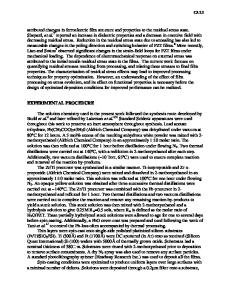Size Effects in Bi-Sb Solid Solutions Thin Films
- PDF / 424,348 Bytes
- 6 Pages / 612 x 792 pts (letter) Page_size
- 60 Downloads / 285 Views
Size Effects in Bi-Sb Solid Solutions Thin Films Elena I. Rogacheva,1 Dar’ya S. Orlova,1 Mildred S. Dresselhaus,2 and Shuang Tang2 1 National Technical University "Kharkov Polytechnic Institute", 21 Frunze St., 61002, Kharkov, Ukraine 2 Massachusetts Institute of Technology, 77 Massachusetts Ave., Cambridge, MA 02139, USA ABSTRACT The room-temperature dependences of the electrical conductivity σ, Seebeck coefficient S, Hall coefficient RH, and the thermoelectric power factor P on the thickness (d=10–300 nm) of the thin films grown on mica substrates by thermal evaporation in vacuum of Bi-Sb solid solutions crystals with 4.5 at.% Sb were obtained. It was established that an increase in d up to ~ 200 nm leads to a change in kinetic coefficients and that in the thickness dependences of the thermoelectric properties, quantum oscillations were observed. It was shown that the monotonic component of the σ(T) dependence can be satisfactorily approximated by theoretical calculations based on the classical Fuchs - Sondheimer theory. The theoretically estimated period of oscillations is in a good agreement with the experimentally observed period. INTRODUCTION Recently, bulk crystals of the Bi -Sb solid solutions and low-dimensional structures based on them have attracted much attention as promising low-temperature thermoelectric (TE) and magnetoelectric materials for refrigerating devices at temperatures below ~ 200 K [1]. The possibility of enhancement of the TE figure of merit in low-dimensional structures [2] has attracted attention to studying Bi-Sb films. On the other hand, these solid solutions are interesting materials for solid states physics, which have extremely low effective electron masses, an anomalously high charge carrier mobility and mean free-path [3]. In the thin film state, a confinement of the charge carrier motion by the film surfaces occurs, which leads to a radical change in physical properties of these materials in comparison with their bulk state. In thin films one can observe two types of size effects: the classical one which takes place when the film thickness d is comparable with the mean free path of the charge carriers l in the material, and the quantum size effect (QSE), when d and the de-Broglie wavelength of the charge carriers λD are of the same order of magnitude [3]. Due to their unique electronic properties, Bi, Sb, and Bi-Sb solid solutions are convenient objects for observation of both classical and QSE, as well as for using these effects for controlling their TE properties. In a number of works, under decreasing d a change in the kinetic properties thin Bi films was observed, for example a growth in the specific resistance ρ, a decrease in the charge carrier mobility μ, thermal conductivity, Seebeck coefficient S, and magnetoresistance [3]. The observed changes in the kinetic coefficients was usually interpreted as a manifestation of the classical size effect, i.e. as a result of the increasing contribution of diffuse scattering of charge carriers at the film surface under decreasing d.
Data Loading...











